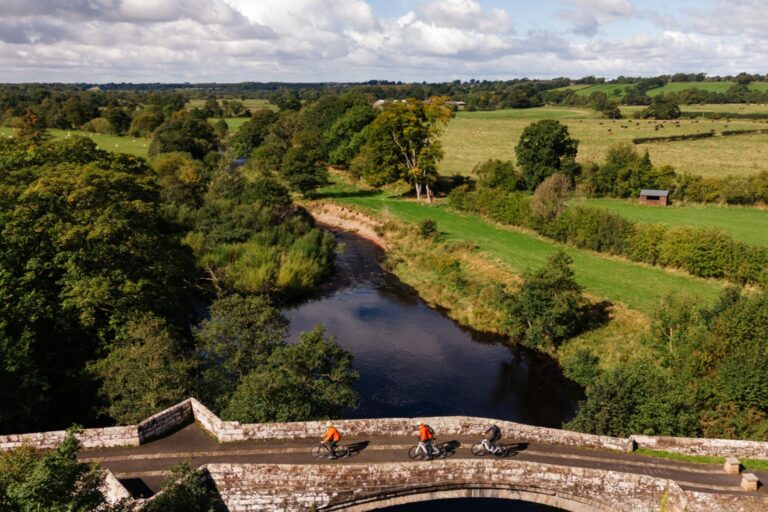November 12, 2024
30 mins
Destination: The North
Share
In this article
A 2025 Guide To Visiting Northumberland
Welcome to the North of England, Northumberland, as far North as you can travel before crossing the border into Scotland. You’ll notice an accent and slight dialect change as well as a small drop in temperature, but only by a couple of degrees! Often viewed as one of the friendliest regions in the country, the warmth and hospitality of the people in this region makes up for the chillier air!
The landscape is wild and rugged and steeped in history. You’ll see influences from The Vikings, The Romans, Scandanavia and the Scots. This area of England has been home to bloody battles, infamous Kings and Queens and magnificent defenses in the form of castles and a very famous wall! With so much to explore, let us show you why you should visit Northumberland in 2025.
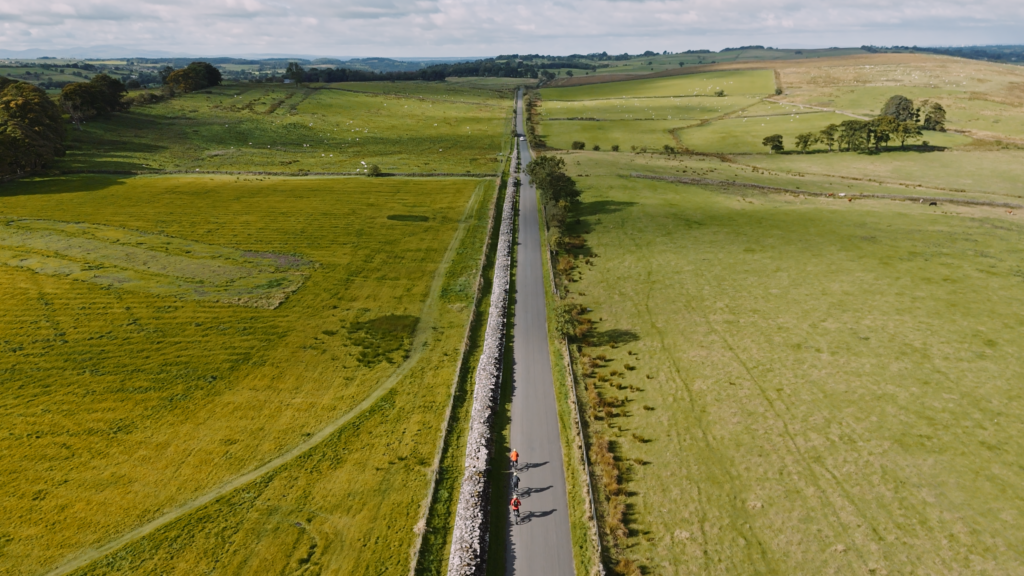
Geography
Where is Northumberland in England?
Northumberland is England’s northernmost County, stretching from the Scottish Border in the north and west, to Tyneside and County Durham in the south.
Northumberland is a county in the northeast of England, bordering Scotland to the north. It is the northernmost county in England and lies along the North Sea to the east. The county is known for its breadth of landscapes, including hills, moorlands, and a dramatic coastline with castles dotted throughout. Interestingly there are no major cities within this vast county, and as expansive as it is to us Brits, it is approximately the same size as the second smallest US state, Delaware!
Northumberland is 1,940 square miles and it is the least sparsely populated county in England, making it a magnificent place to explore! Newcastle-upon-Tyne is the nearest city, located in the bordering county of Tyne and Wear.
Northumberland Map
Travelling in Northumberland
Northumberland is easily accessible from major cities across the UK. From Edinburgh in Scotland, you can reach Newcastle in as little as 1.5 hours. Equally once in central London there are direct trains to Newcastle that take just under 3 hours travelling time. Newcastle is the nearest major city to begin exploring Northumberland. Newcastle sits just outside of the county border, in its own county of Tyne and Wear. From Newcastle there are local train and bus services to Hexham, Alnwick, Bamburgh and Chillgham. For more remote areas and Hadrian’s Wall, it may be easier to hire a car or taxi transfer as public transport connections are not as frequent from some places.
It goes without saying Northumberland has some of the UK’s best walking trails, from coastal paths to hilly landscapes in the National Park. St. Oswald’s Way and the Northumberland Coast Path are popular long-distance routes. So walking is one of the best ways to get up close to the spectacular scenery and enjoy Northumberland.
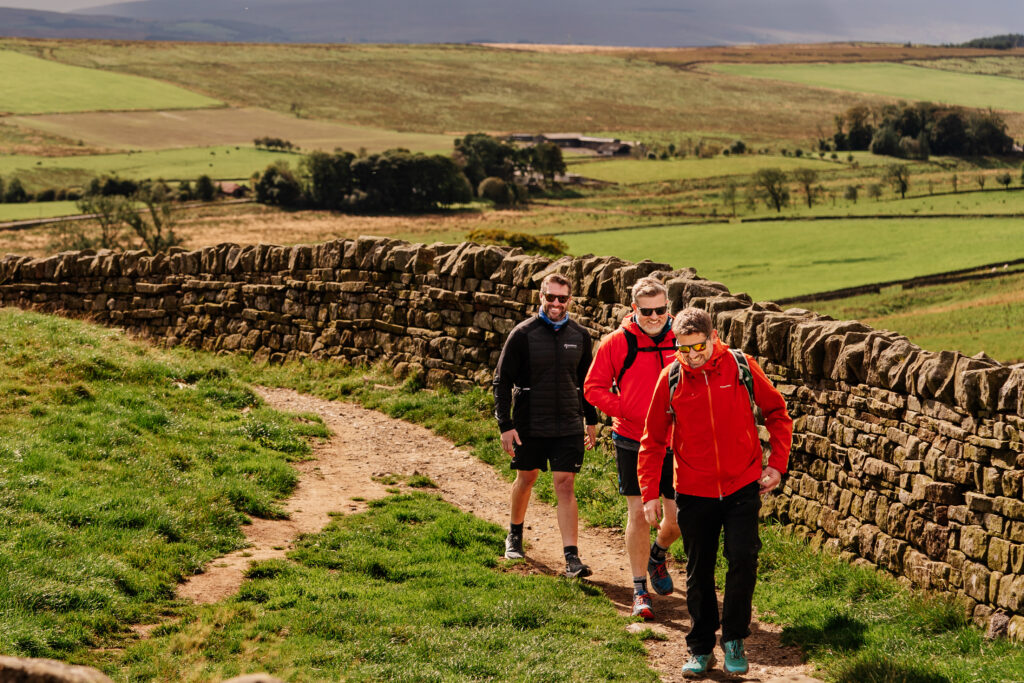
Cycling is also the other preferred way to have a Northern adventure in Northumberland. Northumberland is popular with cyclists due to its scenic routes. There are well-marked trails, like the Sandstone Way, a 120-mile route from Berwick-upon-Tweed to Hexham.
Since the county spans a vast area of the Northeast, you’ll need to use other modes of transportation especially to reach further north such as Bamburgh and Berwick-upon-Tweed. The car is the easiest of these options with the towns and villages being well linked by road. Buses are another option but timings to more remote areas may be less frequent and make it harder to reach your destination quickly.
History of Northumberland
Northumberland played a significant role in the Viking history of England, as it was both raided and settled by Vikings during the early medieval period. Here’s an overview of the Viking history in Northumberland:
Early Viking Raids
The Vikings, seafaring began raiding the British Isles in the late 8th century. Northumberland, as a coastal region, was among the first places in England to face these raids.
Lindisfarne Raid (793 AD), one of the most famous Viking raids in Northumberland occurred at Lindisfarne, also known as Holy Island. The raid on the Lindisfarne Monastery is often considered the beginning of the Viking Age in Britain. The Vikings attacked the island’s monastic community, looting treasures and enslaving or killing many monks. This event shocked Christian Europe.
The Vikings had a lasting impact on Northumberland’s culture, landscape, and society:
Many places in Northumberland have Viking-origin names. For example, names ending in “-by” (meaning village), “-thorpe” (meaning farmstead), or “-ness” (meaning headland) often have Viking roots.
Today, the Viking history of Northumberland is celebrated with various festivals and historical re-enactments, particularly at places like Lindisfarne and York, reflecting the lasting fascination with the Viking heritage in the region.

Northumberland and the Romans
Northumberland’s history with the Romans is one of its most defining periods, marked by the construction of Hadrian’s Wall and the presence of numerous Roman forts, roads, and settlements. The Romans left a lasting legacy in the region, shaping its landscape and history.
The most notable influence that can still be seen today was the construction of Hadrian’s Wall. In 122 AD, Emperor Hadrian ordered the construction of a massive defensive fortification across northern Britain, marking the northern boundary of the Roman Empire in Britain. Hadrian’s Wall, stretching 73 miles from the River Tyne near Newcastle in the east to the Solway Firth in the west, runs through Northumberland.
The wall’s purpose was not only military but also symbolic, marking the edge of the Roman Empire and controlling movement between Roman Britain and the unconquered Caledonian tribes to the north (modern-day Scotland).
The Romans, of course famous for their roads, built a network across Britain, many of which passed through Northumberland and were used for centuries after the fall of the Roman Empire.
As part of the Active England Bike Hadrian’s Wall Tour, you will cycle along former Roman Roads adjacent to Hadrian’s Wall.
Other historical sites that show the Roman heritage include the Roman Army Museum near Walltown Crags. This museum gives visitors a detailed look at the Roman military system and life of the soldiers along Hadrian’s Wall.
Vindolanda, is another Roman site which is an archaeological site and museum giving one of the best insights into life on the Roman frontier. Ongoing excavations frequently uncover new artifacts.
Northumberland remains one of the best places in Britain to explore Roman history, with its forts, towns, and the iconic Hadrian’s Wall, a testament to Roman engineering and imperial ambition.
Northumberland County Today
Northumberland today is a blend of stunning natural beauty, rich history, and vibrant culture, making it an exciting and unique place to explore. With its rugged landscapes, charming towns, and iconic landmarks, this northernmost English county offers something for every kind of traveler.
You can’t trip over without coming across a castle in Northumberland, and if it’s not a fully-fledged castle, it’s magnificent ancient ruins or a Roman fortress. History enthusiasts have a wealth of options to explore.
One of the most notable landmarks along Hadrian’s Wall is the Sycamore Gap. Until September 2023, stood a ginormous, lone Sycamore tree in the gap in the valley, giving the area its name. Sadly, it was illegally felled overnight on 27th September 2023 but in its place is the stump which is showing signs of new growth. There is more information about the tree and a new exhibition nearby at The Sill.
The Northumberland landscape offers not only beauty during the day but even more magic at night. With miles of untamed moorland between each town and very little light pollution, it allows for some of the darkest skies in Britain. Within the county is Northumberland National Park which is home to Kielder Forest. At night, the park becomes one of the best stargazing spots in Europe thanks to its Dark Sky Park status—perfect for astronomy lovers!
Northumberland’s small towns and villages are filled with character, offering cosy pubs, independent shops, and a strong sense of community. Locals are friendly and welcoming and often share anecdotes of times gone by, so it’s always worth paying a visit to the local butchers or village pub for tall tales and a strong pint of Ale!
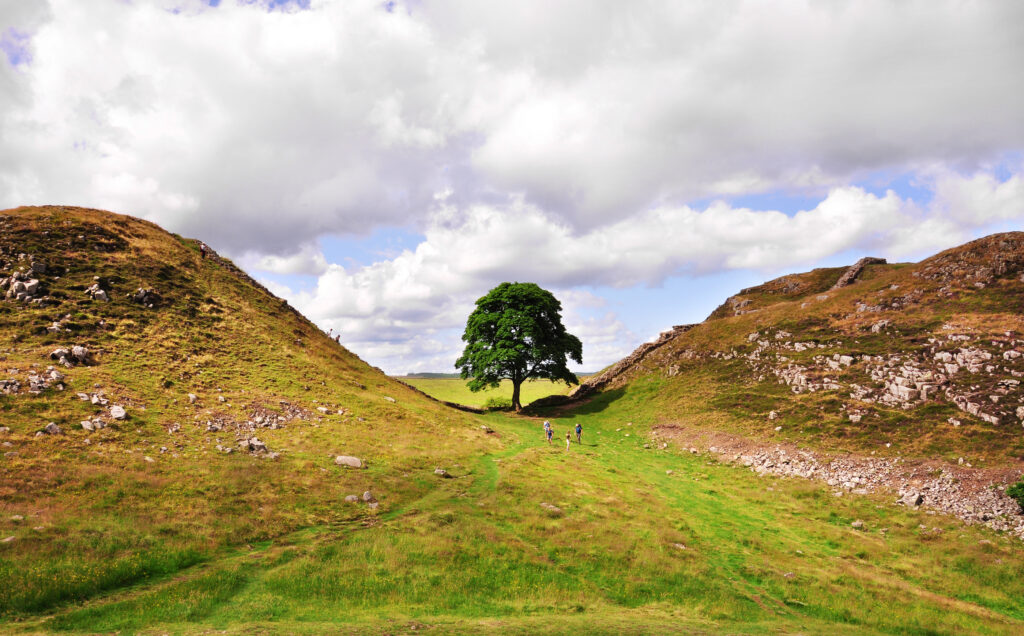
Where to stay in Northumberland
Northumberland, as we’ve touched upon, is a large county and accommodation can be sparse away from the towns and villages. Particularly if walking Hadrian’s Wall, it is advisable to book accommodation in advance as bed and breakfasts may be full during peak summer season and towards the western end of the Wall, accommodation is harder to come by.
Key towns such as Hexham, Alnwick, Chilligham, Bamburgh and Berwick-upon-Tweed all have comfortable Inns, bed and breakfasts and hotels to rest your legs after exploring.
Some hotels we recommend based on locations:
Alnwick
Hogshead Inn located just outside of Alnwick it is perfectly located for Alnwick town centre as well as the National Park and beaches in Alnmouth.
Bamburgh
The Bamburgh Castle Inn overlooks the busy little harbour of the fishing village of Seahouses and is ideally located for exploring Bamburgh Castle as well as the coastal walks and Farne Islands.
Hexham
The County Hotel is situated in the centre of town. Hexham is the nearest town with amenities and public transport to Hadrian’s Wall. It is just over 20 minutes by car to Vindolanda a key Roman Fortress and point of interest along the Wall.
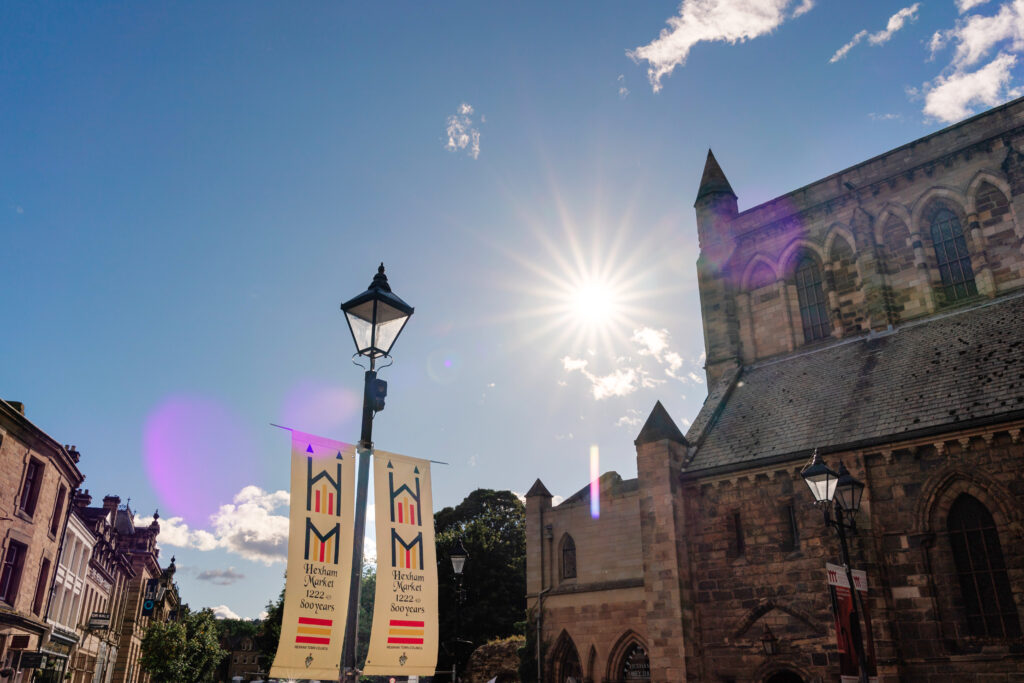
Places of interest in Northumberland?
Within the blog we’ll explore many of these in more detail but here is a list of some of the key places of interest across Northumberland.
Hadrian’s Wall
One of the most iconic landmarks in the UK, Hadrian’s Wall is a UNESCO World Heritage Site that stretches across northern England. https://www.vindolanda.com/local-attractions
Alnwick Castle and Gardens
Known as the “Windsor of the North,” Alnwick Castle is one of the largest inhabited castles in the country and has been home to the Percy family for over 700 years. The castle gained worldwide fame as a filming location for the Harry Potter series. https://www.alnwickcastle.com/
Bamburgh Castle
Overlooking the North Sea, Bamburgh Castle is one of Northumberland’s most impressive coastal fortresses. With over 1,400 years of history, the castle offers fascinating exhibits and breathtaking views of the Farne Islands. https://www.bamburghcastle.com/
Lindisfarne (Holy Island)
Lindisfarne, also known as Holy Island, is a tidal island steeped in history and spirituality. Accessible by a causeway at low tide, the island is home to Lindisfarne Priory, where Christianity was introduced to Northumbria. https://www.lindisfarne.org.uk/
Kielder Water and Forest Park
One of the most beautiful natural spots in Northumberland, Kielder Water is the largest man-made lake in northern Europe, surrounded by the expansive Kielder Forest. It’s a haven for outdoor enthusiasts. https://www.visitkielder.com/
Chillingham Castle
Known as “the most haunted castle in Britain,” Chillingham Castle is a medieval fortress with a long and bloody history. Visitors can explore the dungeons, torture chambers, and grounds, while those interested in the supernatural may enjoy one of the castle’s famous ghost tours. https://chillingham-castle.com/
Cragside House and Gardens
Once the home of Victorian inventor Lord Armstrong, Cragside was the first house in the world to be lit by hydroelectricity. This National Trust property near Rothbury features an impressive house filled with innovations from the 19th century, as well as beautiful gardens and woodland walks. https://www.nationaltrust.org.uk/visit/north-east/cragside/history-of-cragside
Hexham Abbey
Located in the historic town of Hexham, this stunning abbey dates back to AD 674 and is one of the finest examples of early English architecture. Inside, you’ll find beautiful stained-glass windows, medieval tombs, and the famous Saxon crypt. https://www.hexhamabbey.org.uk/
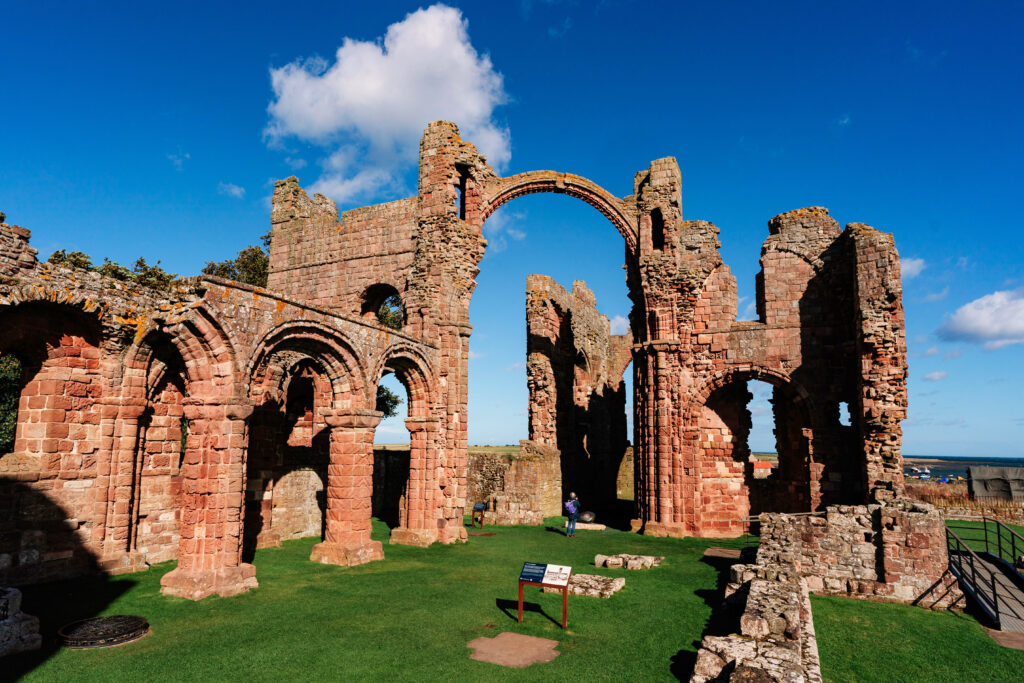
Towns and Villages in Northumberland
Both villages and towns contribute to Northumberland’s rich heritage, with villages offering rural charm and towns providing a wider range of services and amenities.
Northumberland Villages
Alnmouth, Bamburgh and Seahouses are all seaside villages with their own unique charm. From the colourful buildings of Seashouses to the majestic castle of Bamburgh, the villages of Northumberland will offer you a warm Northern welcome!
Northumberland Towns
Berwick-upon-Tweed, Alnwick and Hexham are amongst the larger towns in Northumberland. Hexham provides a variety of accommodation options for exploring Hadrian’s Wall as well as the very exclusive Michelin dining option of Hjem. Berwick-upon-Tweed is the closest border town to Scotland and Alnwick is home to yet another magnificent castle as well as the instagramabale second-hand bookstore Barts Books.
Northumberland Castles
A Northumberland blog wouldn’t be complete without a section dedicated to castles! Home to more castles than any other county in England, you could spend much of your trip visiting castles alone! But with lots of other sights to see, here’s our top 3 castles to visit in Northumberland.
1. Bamburgh Castle:
Perched on the pristine Bamburgh beach with sand dunes and rolling waves in the distance, this castle is steeped in history dating back to AD547. The beachside setting is what sets this castle apart from others. https://www.bamburghcastle.com/
Active England tip: Plan a walk down to Bamburgh beach at sunset for breathtaking golden light across the sand dunes, towards the castle.
2. Chillingham Castle:
This castle holds the title of Britain’s most haunted castle. With little adjustment to the interior, the castle offers guests a fantastic look back in history from the Tudor period. Harry Potter fans can see the backdrop for the films up close as well as having the opportunity to ride a magic broomstick! https://chillingham-castle.com/
Active England tip: If you’re brave enough, you can also stay the night as part of a ghost hunting tour! Find out if it really is as haunted as legend says.
3. Dunstanburgh Castle:
Dunstanburgh Castle stands on a remote headland in Northumberland. It is accessed via a stunning walk from the nearby village of Craster, along the rugged Northumberland coast. The entire walk you have fantastic views across to the castle before arriving at its magnificent walls. https://www.english-heritage.org.uk/visit/places/dunstanburgh-castle/
Active England tip: Stop for lunch at the Jolly Fisherman and if the weather is fine there are outdoor tables offering un-interrupted views of the castle as you enjoy some delicious seafood.
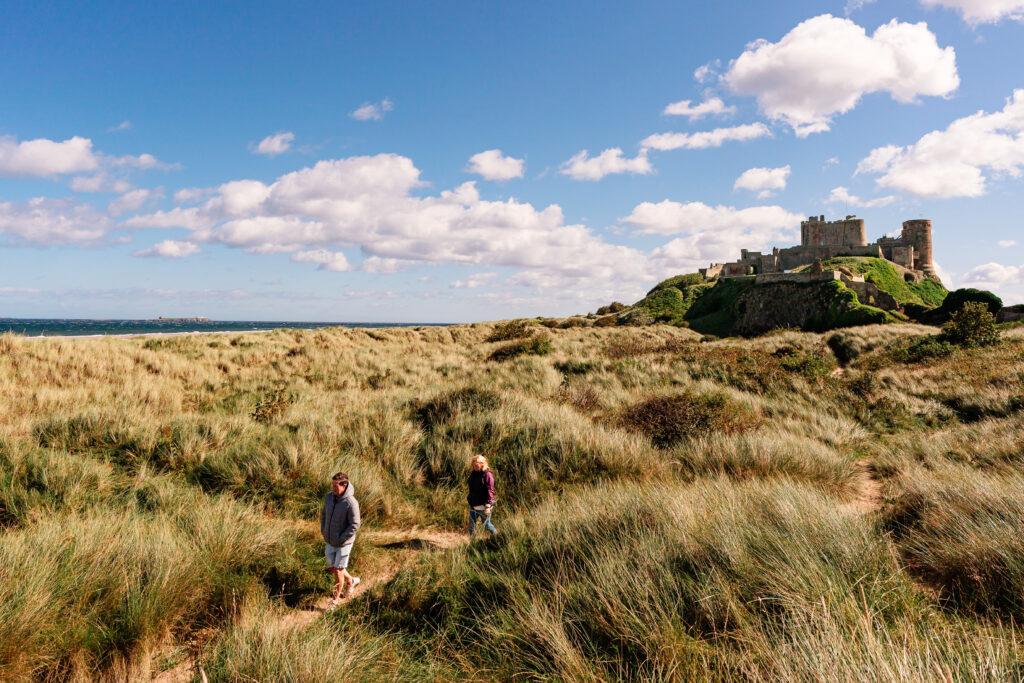
Things to do in Northumberland
Walking in Northumberland
Walking of course is by far the most enjoyable activity to do in Northumberland. The solitude and serenity of Northumberland’s countryside is unmatched, with endless skies stretching above you and the feeling of being completely at peace with nature. You are spoilt for choice with a perfect blend of pristine coastline, dramatic hills, and ancient history, offering a truly immersive experience for walkers of all levels.
The Northumberland Coast National Landscape (formerly AONB) is a narrow coastal strip stretching from Berwick-upon-Tweed to Amble. This bright, wild coast sweeps along some of Britain’s finest beaches and is internationally noted for its wildlife.
Inland there are challenging hillforts and gentler ambles as you follow paths winding through open spaces, woodlands, and quiet valleys. The earthy scent of moorland heather fills the air. The sense of history is palpable here, especially if you wander near Hadrian’s Wall, where ancient Roman ruins rise from the landscape. Along your journey, you’ll come across villages with original stone cottages and inviting local pubs where you can soak up the warmth of Northumbrian hospitality. Perfect for resting your feet along the way!
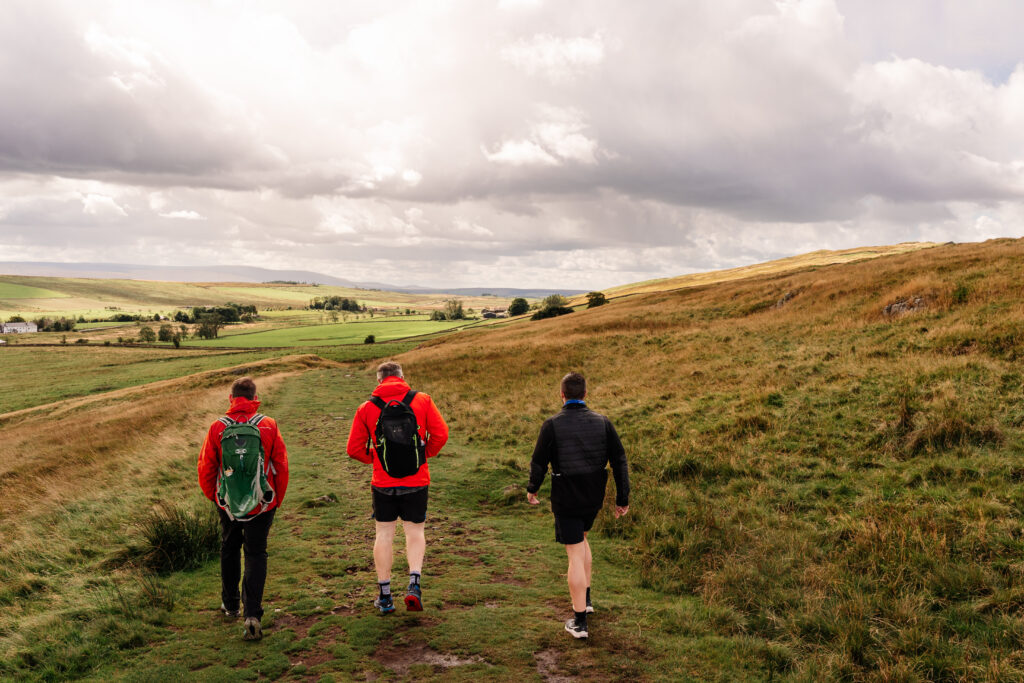
Cycling in Northumberland
Cycling in Northumberland is an exhilarating way to explore this wild and diverse region, offering freedom to roam through its stunning landscapes at your own pace. The experience blends natural beauty, mixed terrain, and a deep sense of history as you pedal through sweeping hills, coastal paths, and charming villages.
The gentle rise and fall of the landscape makes for a mix of easy-going rides and more challenging climbs, with each ascent rewarding you with breathtaking views that stretch for miles.
The Northumberland Coastal Route is a favorite among cyclists. Following the coastline, you can ride beside castles, cliffs and dunes.
Heading inland, you’ll find quiet forest trails and open moorlands. Riding through Kielder Forest, for example, is an adventure in itself. The paths here take you deep into dense woodlands, where the scent of pine fills the air and the tranquil sound of nature accompanies your journey.
For history enthusiasts, cycling along Hadrian’s Wall is an unforgettable experience. The Roman ruins lining your path offer fascinating stops as you traverse rolling countryside. The ancient wall running through the landscape makes you feel like you’re riding through the pages of history.
Northumberland’s cycling routes range from family-friendly tracks to more intense off-road adventures, and no matter where you ride, you’re always close to a cosy village pub or café to rest and refuel.

Northumberland Food & Drink
Northumberland boasts a diverse culinary scene, with eateries ranging from traditional pubs serving hearty meals to coastal restaurants cooking up the freshest seafood, as well as Michelin star fine dining. Whether you’re craving fresh fish, a cosy pub lunch, or a gourmet experience Northumberland’s food offerings are sure to satisfy. Here are some of our favourite places across the region:
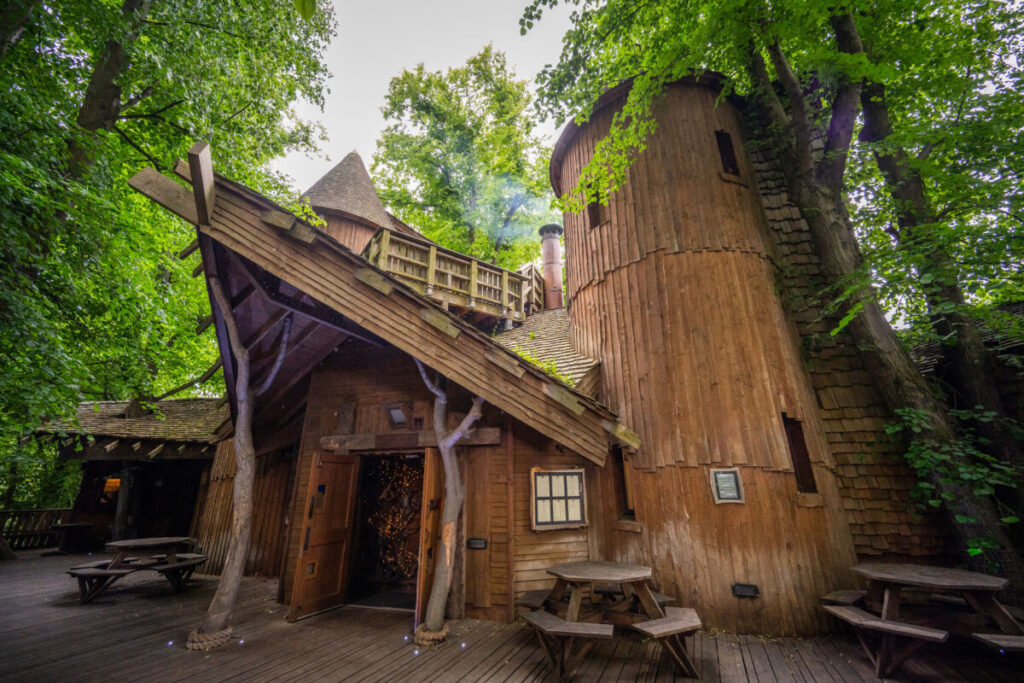
The Treehouse Restaurant – Alnwick
One of the most unique dining experiences in Northumberland, The Treehouse Restaurant is in the enchanting Alnwick Garden. This whimsical restaurant is built high up in the trees, with twinkling fairy lights, wooden walkways, and roaring fires. The menu features locally sourced produce with dishes such as Northumbrian lamb, wild mushroom risotto, and freshly caught seafood. It’s perfect for a special occasion or a magical evening out. https://www.alnwickgarden.com/the-treehouse-restaurant/
The Potted Lobster – Bamburgh
For seafood lovers, The Potted Lobster in Bamburgh is a must-visit. Located near the stunning Bamburgh Castle, this charming restaurant offers fresh, local seafood with a modern twist. Enjoy dishes like lobster thermidor, seafood platters, and crab sandwiches, all served in an intimate setting. It’s the ideal spot after a day exploring the Northumberland coast. https://thepottedlobster.co.uk/bamburgh/
Hjem – Hadrian’s Wall near Hexham
This Michelin star establishment couldn’t be in a more picturesque location. With the stunning Northumberland backdrop, this restaurant offers fine cuisine that sees the very best produce of Northumberland come together with Scandinavian values and cooking techniques. Just a stone’s throw away from Hadrian’s Wall, Hjem, meaning ‘home’ in who have created a tasting menu using ingredients sourced from the surrounding farms and gardens of Northumberland. https://www.restauranthjem.co.uk/
Jolly Fisherman – Craster
If you’re after the famous Craster kippers, then head to The Jolly Fisherman. Known for its beautiful coastal views and hearty seafood offerings, this pub specialises in Craster kippers, freshly caught lobster, and other local delicacies. It’s an ideal stop if you’re walking along the Northumberland Coastal Path and want a relaxing meal with a fantastic view of Dunstanburgh Castle. https://thejollyfishermancraster.co.uk/
The Percy Arms – Chatton near Chillingham
Located just a short drive from Chillingham in the village of Chatton, The Percy Arms is a traditional country pub and a favourite for those visiting the area. It offers a cosy and welcoming atmosphere, with a menu that focuses on locally sourced, hearty British dishes. Expect classic pub fare with a modern twist, featuring local game, meats, and seasonal produce. Their Sunday roasts are especially popular, and the selection of ales and wines makes it a perfect spot to relax after exploring Chillingham Castle. https://percyarmschatton.co.uk/
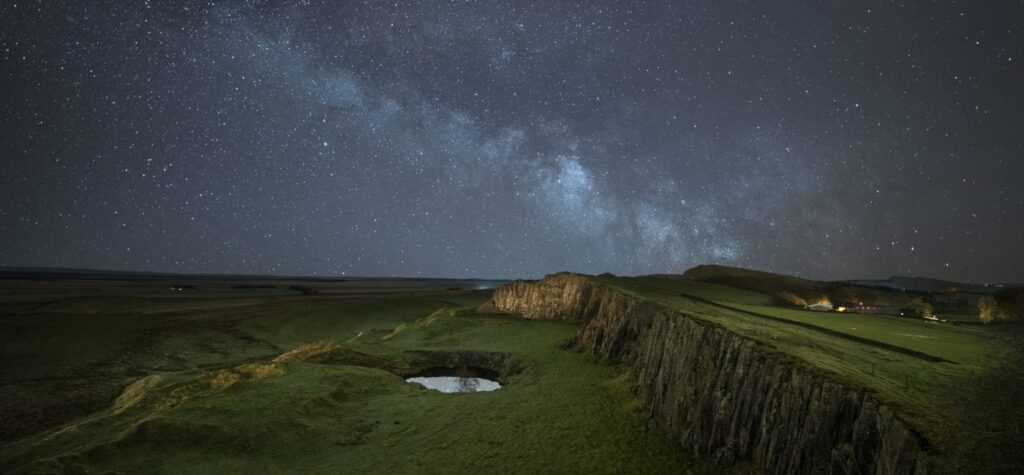
7 Interesting facts about Northumberland
1. Northumberland county is home to the greatest number of castles across England
Northumberland is home to more castles than any other county in England. With over 70 castles, it earned the nickname “The Land of Castles.” Some of the most famous include Alnwick Castle, Bamburgh Castle, and Chillingham Castle.
2. Northumberland National Park has international Dark Sky Status
Northumberland National Park is one of the most remote and least populated areas in England. It is also part of Northumberland International Dark Sky Park, which is Europe’s largest area of protected night sky, making it one of the best stargazing spots in the world.
3. The Farne Islands are a wildlife have and are home to a large colony of Puffins amongst others
The Farne Islands, off the coast of Northumberland, are home to one of the largest colonies of puffins in the UK. During the breeding season (April to July), the islands teem with these iconic birds, alongside seals and many other seabird species.
4. Chillingham ‘Wild Beasts’ roam freely at Chillingham Castle
Not only is Chillingham Castle dubbed Britain’s most haunted castle, but it is also home to animals rarer than any endangered Panda or Mountain Gorilla! They are the only wild cattle in the world, sole survivors of herds that once roamed the forests of Britain. Once they were held sacred and pre-Christian pagans sacrificed them to their gods. You can arrange to visit the herd, accompanied by the local warden.
5. Alnwick Castle is a Harry Potter fans dream
Alnwick Castle has been used as a filming location for several famous films and TV shows, most notably as Hogwarts in the first two Harry Potter films. The castle still hosts broomstick-flying lessons for visitors, paying homage to its magical connection.
6. Northumberland has its own flag derived from the Anglo-Saxon era
Northumberland has a distinct county flag, consisting of red and yellow alternating squares, symbolising the region’s Anglo-Saxon heritage. The Northumbrian flag is based on the banner of the Anglo-Saxon kings of Bernicia.
7. Berwick-upon-Tweed has been both Scottish and English territory over time
The town of Berwick-upon-Tweed changed hands between England and Scotland at least 13 times over the centuries, making it one of the most contested towns in British history.
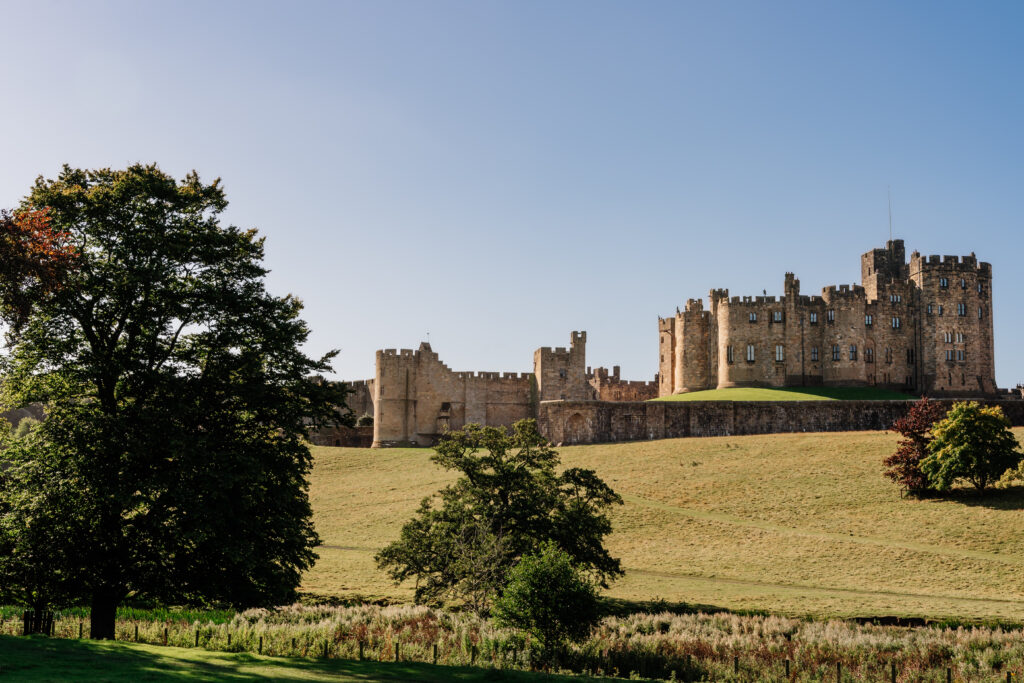
Northumberland Events calendar 2025
In 2025, Northumberland offers a variety of exciting events that highlight its rich culture, natural beauty, and historical significance. Here are some key events to look forward to:
Spring & Summer Festivals:
Northumberland’s coastline and waterways come alive with festivals. The Farne Islands Puffin Festival and Alnmouth Arts Festival are popular, celebrating wildlife and local arts. Outdoor concerts and food festivals are also a summer highlight, including local farmers’ markets and seafood events.
Historical Reenactments:
Northumberland’s strong ties to Roman and medieval history are celebrated through reenactments at places like Vindolanda and Bamburgh Castle, offering immersive experiences of Roman Britain and Viking invasions.
Dark Skies Events:
Northumberland is famous for its International Dark Sky Park, with regular stargazing events, particularly in autumn and winter. The annual Dark Skies Festival showcases astronomy talks and night-time hikes.
Christmas Markets & Winter Magic:
In winter, the county hosts festive markets in towns like Hexham and Morpeth, with a blend of Christmas shopping, twinkling lights, and ice skating. Not forgetting delicious Mulled Wine and locally produced sweet treats to enjoy throughout the festive season.
For dates and an extensive list of events in Northumberland, check the Visit Northumberland website.
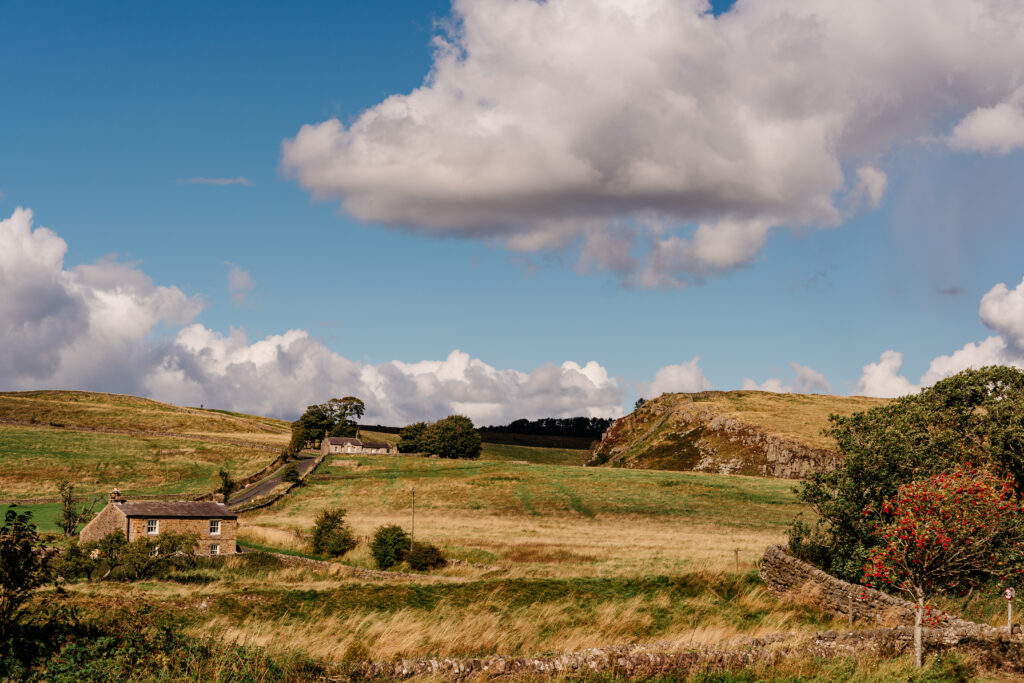
If you’ve made it to the end of the blog, perhaps we’ve inspired you to see Northumberland for yourself! Southern England often takes all the glory for the sunnier and slightly warmer climate, but the North really has a special charm and unique countryside to explore. Check out our Active England Northumberland tours for your future Northern adventure!
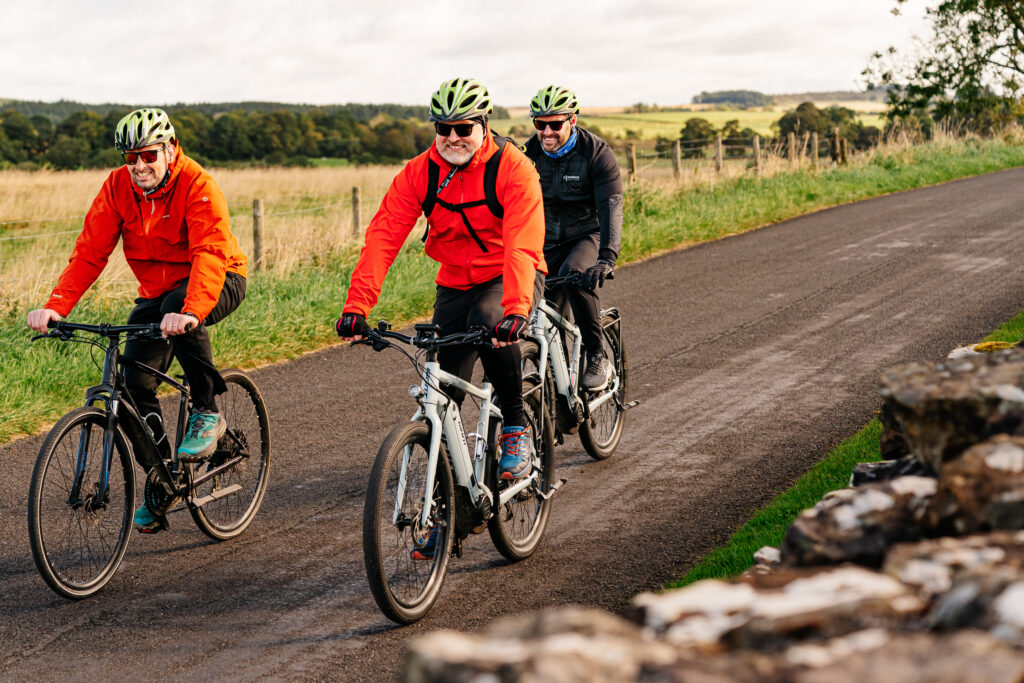
That concludes our bumper guide to Northumberland – what do we miss? Let us know in the comments below.


